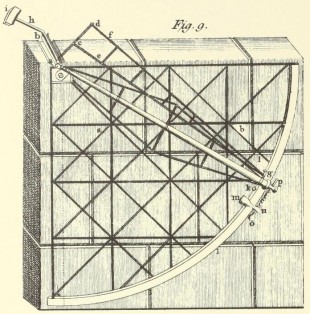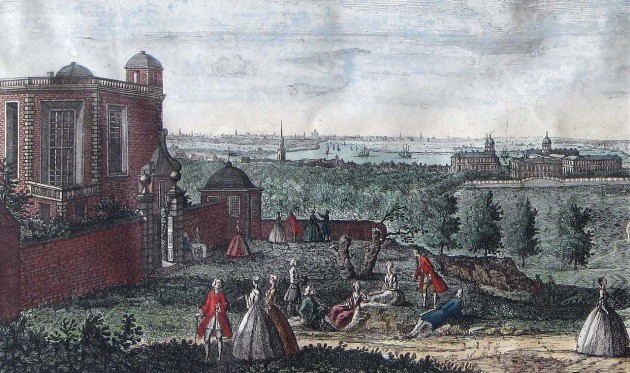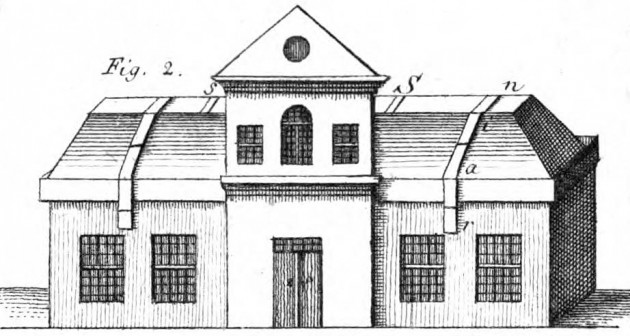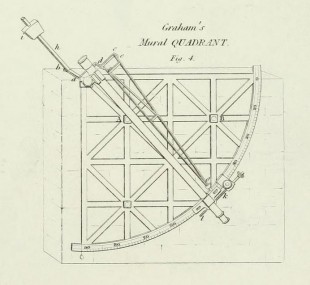…where east meets west
- Home
- Brief History
- The Greenwich Meridian
- Greenwich
(1675–1958) - Herstmonceux
(1948–1990) - Cambridge
(1990–1998) - Outstations (1822–1971)…
- – Chingford (1822–1924)
- – Deal
(1864–1927) - – Abinger
(1923–1957) - – Bristol & Bradford on Avon
(1939–1948) - – Bath
(1939–1949) - – Hartland
(1955–1967) - – Cape of Good Hope
(1959–1971)
- Administration…
- – Funding
- – Governance
- – Inventories
- – Pay
- – Regulations
- – Royal Warrants
- Contemporary Accounts
- People
- Publications
- Science
- Technology
- Telescopes
- Chronometers
- Clocks & Time
- Board of Longitude
- Libraries & Archives
- Visit
- Search
Telescope: Halley’s 8-foot Iron Mural Quadrant (1725)

Halley's Mural Quadrant. From Bion, The Construction and Principal Uses of Mathematical Instruments, (London, 1758)
Commissioning of the instrument
When Halley arrived as Flamsteed’s successor as Astronomer Royal, he found the Observatory devoid of any instruments. The Quadrant was commissioned as a replacement for Flamsteed’s Mural Arc which had been removed together with all the other instruments, by Margaret Flamsteed when she left the Observatory in March 1720 following the death of her husband (letter: Crosthwait to Sharp).
After an unsuccessful attempt by the Government’s law officers to recover the instruments, Halley petitioned the King to bestow upon him a sum of money sufficient to re-equip it. He was awarded £500 of which £61.10s (plus 2.5% duty and other fees) was spent on a transit instrument. Halley also spent a small sum re-equipping the Great Room (Octagon Room). The rest was destined for two mural quadrants which Halley commissioned from the celebrated London instrument maker George Graham. His plan was to have them mounted facing opposite directions on the two sides of a newly built freestanding wall, thereby enabling a view of the whole sky to be obtained. In the event, the money ran out and only one instrument was completed. It was mounted on the east side of the wall looking south.
Rather than re-use Flamsteed’s meridian wall which was known to be subsiding, Halley had a new freestanding wall erected immediately to its north and fractionally to its east (about 1.85m). Made from eleven large pieces of stone (a foundation slab with five rows of two stones on top), it was positioned in the midle of a newly erected building. Although there is no known plan or detailed description of the building, it is believed to have been either square or rectangular in shape with its north-eastern corner breaking though the Observatory’s eastern boundary.

The Observatory in 1736. On the extreme left, the corner of Halley's Quadrant House can be seen breaking through the boundary wall. Detail from Prospect of Greenwich from the Observatory... . Engraved by St. Torres after J. Rigaud, 1736. Printed for Robert Wilkinson London (No. 58 Cornhill)
The instrument’s construction
The Mural Quadrant consisted of an 8-foot radius calibrated brass arc supported by an iron framework made by Jonathan Sisson, the heavenly bodies being observed through a braced and counterbalanced radially mounted telescope. As with Flamsteed’s Mural Arc, the scale divisions were marked out at the Observatory itself. However, whilst those of the Mural Arc were marked with the instrument in situ, those of the Quadrant were marked out with the instrument lying on the floor of the Great Room. This part of the operation was carried out in an innovative way by Graham using a beam compass. Unlike any previous quadrant, this one was marked with two independent concentric sets of scale divisions. The inner scale was divided into 90 divisions, each of one degree, which were then subdivided into 12 equal parts of five minutes of arc. The outer scale was divided into 96 equal parts, each of which was also subdivided. With the help of a vernier and later a micrometer, both could be read to the nearest second of arc. The reason for having the second scale was that it was likely to be more accurate as unlike the degree scale, it could be marked off by simple a process of multiple bisection. Further subdivisions of the two scales were read off with a vernier. In use, both scales were read and recorded with the outer scale reading then being converted into degrees by simple arithmetic. Click here to see some examples as recorded by Maskelyne in 1774 (note: some of the observations were made with the later Bradley Quadrant; those made with the Halley Quadrant are marked NQ. or N.Q. in the widest column.
The accompanying clock was month going and also made by Graham. Known as Graham 2 since Airy’s time, it remained in the Quadrant Room, most probabaly on the south wall, until the first part of the nineteenth century (1834?) when it was moved to the Circle Room.
State of the Instruments when Bradley became Astronomer Royal
The following account is taken from is taken from: Miscellaneous Works and Correspondence of the Rev. James Bradley (Oxford, 1822), pp.381–3).
WHEN I came to reside at the Observatory, in June 1742, I made but few observations either with the mural quadrant or transit instrument, till I had made some alterations in both. For there being no good method of illuminating the wires of the telescopes either of the quadrant or transit instrument, I soon found it necessary to make proper apparatus's for that use. Dr. Halley seldom attempted to make observations when the wires required to be illuminated, but when he found that to be necessary, he usually (for the quadrant) placed a candle upon the south end of the wall on which it hangs, which shining upon the inside of the shutter, (which was painted white,) the light was from thence reflected through the object-glass upon the wires in the focus, and by raising the shutter (which slided up and down) till the upper edge of it was in part before the object-glass, more or less light was reflected into the telescope. But this way being inconvenient, especially in windy weather, I soon found it necessary to make a more useful apparatus, by fixing a lamp in a box near the object-glass, which shining on a pasteboard that was fixed on the telescope, and inclined in an angle of 45° to its axis, and through which an elliptical aperture was made to permit the light of the stars, &c. to pass to the object-glass; I could by this means illuminate the wires more or less as the case required, by pulling a packthread reaching to the eye end of the telescope, which would raise or fall a shutter that was before the box, and intercepted the light of the lamp; by this contrivance I could very readily and conveniently adapt the strength of illumination to the object I was observing.
The roof of the quadrant room was so near the top of the stone wall, that in some seasons the warping of the timber would cause the leaden weight which balances the telescope of the quadrant to rub against the boards, so that in some positions it required a pretty considerable degree of force to move the telescope; which may be supposed the reason why the too great stiffness with which it turned about the brass cylinder was not duly attended to, otherwise the accident which happened of breaking the screws with which that cylinder was fastened to the centre plate might have been prevented, by putting a little fresh oil to it. It was on the 5th of July 1742 that I first discovered those screws to be broken, and that the centre cylinder then adhered so firmly to the steel collar, that it required a considerable force to get it out after I had taken the collar off with the cylinder and carried it to Mr. Graham, who rectified it, and then new screws were made, and the cylinder (after it had been turned a little smaller) was again fixed on, July 9, 1742.
While Mr. Graham was rectifying the cylinder, &c. I examined the position of the quadrant as it then hung, which was in the same situation that Dr. Halley left it, I having before the 6th of July neither altered nor examined the situation of the vertical line. By the memorandum entered that day, it appeared that upon supposition that the line of collimation of the telescope was truly adjusted to the beginning of the nonius, the zenith distance to the south shewn by the quadrant would have been too small by 34".
After the beginning of August 1742 I was able to examine likewise the position of the plane of the mural quadrant, by comparing the observations of the times of the passage of the stars at the quadrant, with those observed with the transit instrument, which I got altered in several respects by Mr. Sisson: and before I made use of it, I had likewise contrived a proper apparatus for illuminating the wires in all positions, which was wanting in Dr. Halley's time. The telescope of the transit instrument was likewise now balanced, so that it would stand in any inclination, (whereas in Dr. Halley's time the eye end being heaviest, he was obliged to support it at the proper altitude, upon which account, observations could not be made so expeditiously as now.) At the same time Mr. Sisson put in two other wires (15' from the middle wire) to be made use of for taking of the transit of objects, in case clouds, &c. should hinder me doing it at the middle wire. I had likewise a new level made for adjusting the axis truly horizontal. These alterations were made, and the line of collimation of the transit instrument was adjusted about July 24, but it could not be properly directed till I had a clear view of the mark which Dr. Halley had made on the park wall, the sight of which was intercepted by the boughs of trees which had grown up since Dr. Halley had used this instrument. These being cut away about the end of July 1742, I then set the instrument by his mark, which I at first supposed to be exactly in the meridian, but afterwards found that it lay 12" or 15" in azimuth to the west of the true meridian. 'Between the 1st and 14th of August several stars were observed by the transit instrument and the quadrant, and by comparing the times of their transits, the errors of the plane of the mural quadrant were found to be as entered in the Table before August 14, 1742.The quadrant was not altered till Aug. 18, when it was rectified; so that the centre lay exactly over the beginning of the divisions or the 0 point, and then a plummet hung from the notch at top at the centre plate was found to correspond well with the point on the limb below, to which it had been at first adjusted by Mr. Graham in 1726.
Aug. 20th, I first altered the plane of the quadrant, and by the method then described I brought the plane to lie much truer than it did as left by Dr. Halley, as appears by the Table of errors then found. About the end of August the telescope of the quadrant was taken off and sent to London, where several alterations were made to it, and after it was brought back again I adjusted the line of collimation, (on Sept. 11,) Mr. Sisson having made for me a new apparatus for that purpose.
N. B. By the observations of the transits of low stars that were observed at both instruments about Aug. 20 and 24, I judged that the 3d whole ballister on Mr. Stanhope's house lies very near the true meridian.
After the line of collimation of the quadrant telescope had been adjusted on Sept. 11, several transits were observed at both instruments, from which a Table of errors was collected as entered about the 19th of September 1742.
These errors may be made use of till Oct. 2, 1742, when I made some alteration in the position of the plane; the errors of which are contained in the Table entered Oct. 6th, which may be made use of till the next rectification.
The errors in the plane of the mural quadrant as determined from the observations made between 1 and 14 August 1742 are plotted below:
Later alterations and history
| 1745 | Micrometer fitted to telescope by John Bird. 3-inch focus eyepiece substituted with one of 2-inch focus. | |
| 1749/50 | Quadrant room (but not the quadrant wall) demolished. New quadrant room built as part of Bradley’ s New Observatory. | |
| 1750 | Bradley’s 8-foot Brass Mural Quadrant (by John Bird) mounted on other side (west side) of the quadrant wall facing north |
|
| 1753 | Halley’s Quadrant dismounted for re-division of the scale by Bird. Bradley’s Quadrant mounted in its place. Halley’s Quadrant remounted on west side facing north. |
|
| 1775 | 26 June, Gold points were put to the Quadrant for adjusting the plumb-line. |
|
| 1779 | Roof openings widened from 6 inches to 3 feet, together with alterations of the building to try and obtain a more even temperature. The recorded observations imply that thermometers were fixed into the telescope tubes of both the Hadley and the Bradley Quadrants at this time. |
|
| 1780 | ?Moveable eyepiece applied to telescope? (Ref: Howse). An entry in the published observations states that on July 30, two Holes were inserted in telescope tube near object-glass to give free circulation of air though the tube, the air having free passage in by the side of the eye-glass. It is not clear which of the two quadrants Maskelyne was refering to. Neither tube as they presently exist appears to have any holes at the top end of the tube. A detailed examination from a ladder would be necessary to confirm this. |
|
| 1786 | 23 Feb, Five pound weight added to counterpoise. ‘Guard applied to plum-line to defend it from the air’. New wires put to the focus of the telescope. |
|
| 1789 | 7 June, Achromatic object glass fitted by Dollond. | |
| 1812 | 15 January. Last recorded observation (Polaris). Observation marked NQ (for North Quadrant). Howse mistakenly states 1 August. |
|
| 1839 | West side of Quadrant Room converted into fireproof store, but with quadrant still in place. | |
| 1887 | 18 November, Dismounted from quadrant wall and hung on west wall of the Transit Circle Room as a relic. New pier built on top of quadrant wall for equatorial telescope. | |
| 1911 | Last time counterpoise recorded in the inventory: in Lower Museum Case E, separate from the rest of the instrument. Condemned sometime before 1926. (RGO39/4/121) | |
| 1952 | Dismounted from Transit Circle Room for conservation by the National Maritime Museum to whom it was transferred. (Ref: Howse). |
|
| 1967 | Remounted on west side of quadrant wall. Building opened to the public as part of the National Maritime Museum. Object ID: AST0970 | |

Bradley's New Observatory in 1769. The quadrant wall was located between the windows of the west wing (right). From Bernoulli Lettres astronomiques ... , (Berlin, 1771)
Current Status
On public display in the Meridian Building at the Royal Observatory, Greenwich. Several parts are now missing, including the counterbalance and plumbline. Visiting details.
Contemporary accounts
Smith, Robert. A Compleat System of Optiks in Four Books, (Cambridge, 1738), pp. 332–41 & Plate 49, Figs. 591–7 & Plate 50, Figs. 598–601
Bion, N. The Construction and Principal Uses of Mathematical Instruments, (London: J. Richardson, 1758), pp.275–9 & Plate 2, Figs 9 & 10
Bradley, James. State of the Instruments at the Greenwich Observatory when Dr. Bradley became Astronomer Royal (from Miscellaneous Works and Correspondence of the Rev. James Bradley (Oxford, 1822), pp.381–3)
Maskelyne, Nevil. Astronomical Observations, Volume 1, (London, 1776) pp.i & vi–ix
Rees’s Cyclopaedia in 39 Volumes. Description: Volume 29, (London, 1819), Mural Quadrant by Graham. Plate: Plates Volume 1, (London, 1820), Astronomical Plate XXIII, Fig. 4
A note about different illustrations of the quadrant
The earliest illustration to show the complete ‘Greenwich Quadrant’ was published by Smith in Book 3 of his A Compleat System of Optiks (1738). It was accompanied by numerous other diagrams illustrating the component parts (for link, see above). For reasons unknown, the quadrant wall is shown as being made up of three rows of three stones rather than a foundation slab with five rows of two stones on top. The image was copied for Bion’s 1758 reprint of The Construction and Principal Uses of Mathematical Instruments (for link, see above).The illustration alongside from Rees’s Cyclopaedia is described as ‘a representation of the mural quadrant of Graham’s construction, which will equally represent that of Bird’. It fails to show the dual nature of the calibrated scale. It may derive from another variant that was published in Encyclopédie des sciences, des arts et des métiers (second edition 1769). In this version, a clock is shown mounted against the short side of the quadrant wall. Plate X shows the complete instrument and Plates XI, XII and XIII its component parts and how it was graduated. A cropped version of plate X appears to have been used by Maunder in his volume The Royal Observatory Greenwich a glance at its history and its work. (Click here to view the image as used by Maunder). What appears to be a mirror image of Plate X from the Encyclopédie was published as Plate LXXIX in The New Royal & Universal Dictionary of Arts & Sciences in 1770/71.
Further Reading
Baily, Francis. Some Account of the Astronomical Observations made by Dr. Edmund Halley, at the Royal Observatory at Greenwich. Memoirs of the Royal Astronomical Society Vol.VIII, pp.169–190 (1835)
Rigaud, S. P. Some Particulars respecting the principal Instruments at the Royal Observatory at Greenwich, in the time of Dr. Halley. Memoirs of the Royal Astronomical Society, Vol. 9, pp.205–27, (1836)
Chapman Allan. Dividing the Circle, the development of critical angular measurement in astronomy 1500–1850 (Ellis Harwood, Chichester, 1990)
Bennett, J. A. The English Quadrant in Europe - Instruments and the Growth of Consensus in Practical Astronomy (from Journal for the History of Astronomy, Vol.23, No. 1/Feb, p.1, 1992)
Last time counterpoise recorded in the inventory (in the Record Room separate from the rest of the instrument). (RGO39/4/121)
© 2014 – 2025 Graham Dolan
Except where indicated, all text and images are the copyright of Graham Dolan
